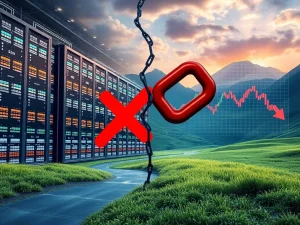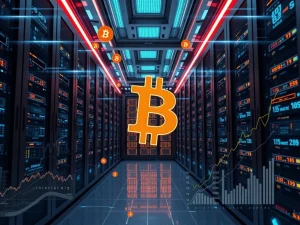Unprecedented Success: How 5 Solo Bitcoin Miners Earned Over $350K Each in 2025

The world of **Bitcoin mining** often appears dominated by industrial-scale operations. Huge farms with advanced hardware seem to leave little room for the individual. Yet, 2025 delivered an astonishing series of events. Five independent **solo Bitcoin miners** defied astronomical odds. Each successfully mined a block and secured rewards exceeding $350,000. This remarkable **crypto mining success** story reminds us of Bitcoin’s unpredictable and democratic spirit. It proves that even small-scale participants can achieve significant wins.
Unprecedented Wins: Solo Bitcoin Miners Defy the Odds
Bitcoin (BTC) mining validates transactions and secures the network. It involves solving complex cryptographic puzzles. Large-scale mining farms typically dominate this process. They utilize advanced, specialized hardware. Consequently, the probability of a lone individual, or **solo Bitcoin miner**, striking digital gold remains incredibly low. In 2025, mining difficulty reached an all-time high. For a solo miner using standard hardware, success was comparable to winning a major lottery. The Bitcoin network’s total hash rate consistently increased. Therefore, a small-scale miner with limited computing power faced exceptionally slim chances. For example, a miner with a 100-TH/s machine, like a high-end Antminer S19, had less than a 0.0001% chance of solving a block daily. As a result, earning a single **Bitcoin block reward** could take months or even years.
Did you know? Satoshi Nakamoto initiated Bitcoin mining with the “genesis block” on Jan. 3, 2009. This first block awarded 50 BTC. Every miner since has built on that foundational proof-of-work legacy.
2025’s Remarkable Bitcoin Block Reward Victories
Each of the five solo **Bitcoin miner** victories involved successfully solving a block independently. These feats are nearly unprecedented in Bitcoin’s mining history. The rewards were valued at around $350,000 each. These individual triumphs highlight the network’s decentralized nature.
- Block 883,181 (Feb. 10, 2025): An independent miner secured this block. They received a reward of 3.125 BTC. This was valued at over $300,000 at the time. The anonymous miner processed 3,071 transactions. This block yielded a total reward of 3.15 BTC.
- Block 903,883 (July 4, 2025): A solo miner with just 2.3 petahashes per second (PH/s) mined this block. They received 3.173 BTC. This was valued at approximately $349,028. The likelihood of this success was about one in 2,800 per day. This equates to roughly once every eight years for that specific hash rate.
- Block 907,283 (July 26, 2025): Another independent **Bitcoin miner** used the Solo CKPool service. They successfully mined a block on this date. The miner received the block reward of 3.125 BTC. It was valued at $372,773 at the time. Block number 907,283 included 4,038 transactions. It generated $3,436 in transaction fees.
- Block 910,440 (Aug. 17, 2025): A solo miner, again utilizing Solo CKPool, mined block 910,440. They collected the standard 3.125 BTC. Additionally, they received about 0.012 BTC in transaction fees. Their total rewards reached approximately $373,000 in Bitcoin. The block processed 4,913 transactions, totaling $1,455.
- Block 913,632 (Sept. 8, 2025): An individual **Bitcoin miner** successfully mined block 913,632. The miner’s reward was 3.14 BTC. This was then valued at $348,111. This total included the standard 3.125 BTC block reward. It also added 0.019 BTC from transaction fees. The block contained 1,956 transactions.
These victories clearly demonstrate that individual miners can still overcome formidable odds. This occurs even as large-scale operations dominate mining. Together, these wins showcase Bitcoin’s unique combination of unpredictability, decentralization, and opportunity. Therefore, they inspire many aspiring miners.
Did you know? Bitcoin block rewards halve roughly every four years. In 2024, the reward dropped to 3.125 BTC per block. Halvings reduce miner income. However, they often precede price rallies. This creates anticipation across the crypto market. These events highlight how mining shapes Bitcoin’s monetary policy and scarcity over time.
Factors Fueling Solo Bitcoin Mining Success in 2025
Individual miners rarely succeed in solving a block. Large mining companies, such as Bit Digital, Riot Blockchain, and Marathon Digital, typically validate most Bitcoin blocks. They possess immense computational power. In 2025, **solo Bitcoin mining** successes resulted from a unique blend of network and market factors. High levels of on-chain activity played a crucial role. Consequently, miners received not only the standard 3.125-BTC block reward but also substantial additional fees. This significantly increased their earnings. Furthermore, Bitcoin’s price consistently stayed around or above $100,000 throughout 2025. This made the rewards highly valuable.
What made these earnings stand out was the solo miners’ ability to win rewards with small-scale equipment. Typically, solo miners with just a few rigs face extremely low odds. However, when they succeeded, they gained the same large, fee-enhanced rewards as large-scale operations. This transformed their modest setups into one-time gains exceeding $350,000. The foundational concept of Bitcoin, outlined in Satoshi Nakamoto’s white paper, established a fixed supply of 21 million BTC. Of this total, over 19 million BTC has already been distributed to miners as **Bitcoin block reward**s.
Did you know? Bitcoin mining consumes significant electricity. Its annual consumption is comparable to some nations. Critics highlight environmental impact. However, miners increasingly shift to renewable sources. These include hydropower, solar, and geothermal.
Understanding Bitcoin Hash Rate and Network Security
**Bitcoin hash rate** is a critical factor in mining. It measures the total computing power applied to solve the network’s cryptographic puzzles. A higher hash rate strengthens network security. It makes tampering with transactions much harder for malicious actors. For miners, the hash rate directly determines their probability of successfully mining a block. Large mining pools combine their hash rates. This improves their chances of consistent rewards. Conversely, solo miners with lower hash rates face much smaller odds.
The Bitcoin network dynamically adjusts its mining difficulty. This occurs every 2,016 blocks. It aims to maintain an average block time of about 10 minutes. This adjustment happens regardless of the total computing power. This mechanism ensures fairness and stability. However, it also increases competition as the global hash rate rises. Overall, the hash rate indicates both the security of the Bitcoin network and the economic feasibility of mining. According to CoinWarz, on Jan. 1, 2025, the hash rate was 702.8319 exahashes per second (EH/s). It then surged to 1,285.6948 EH/s by Sept. 20, 2025. This clearly illustrates the consistent increase in mining difficulty on the Bitcoin network.
Enabling Solo Bitcoin Mining: Platforms and Challenges
Platforms like Solo CKPool provide the technical framework for independent miners. They connect directly to the Bitcoin network. Unlike large mining pools, which distribute rewards among many participants, these platforms offer a different model. They allow a **solo Bitcoin miner** to receive the entire payout if they successfully solve a block. This approach supports decentralization. It also offers stable connections and reliable software support. However, the journey remains challenging.
Solo miners face significant expenses. These include energy costs and the purchase and maintenance of ASIC hardware. They compete against a global network with immense computational power. The chances of success are very slim. This requires considerable patience, as many miners may never solve a block. Nevertheless, the potential for substantial rewards, especially during periods of high transaction fees, makes the effort worthwhile for some. These platforms create vital opportunities for independent miners. They enable remarkable victories against formidable odds. Such **crypto mining success** stories underscore Bitcoin’s open and permissionless structure. Satoshi Nakamoto’s vision for Bitcoin was a decentralized network. Here, anyone with computational power could mine and compete for block rewards. These wins strongly suggest that successful Bitcoin mining is not solely the monopoly of mining pools. Even small, independent miners can achieve extraordinary success.









